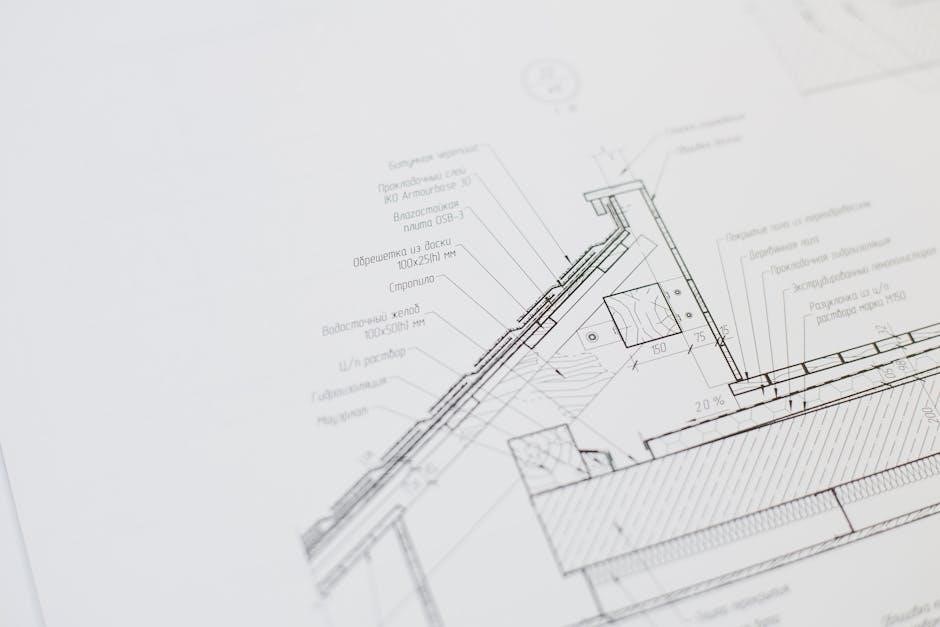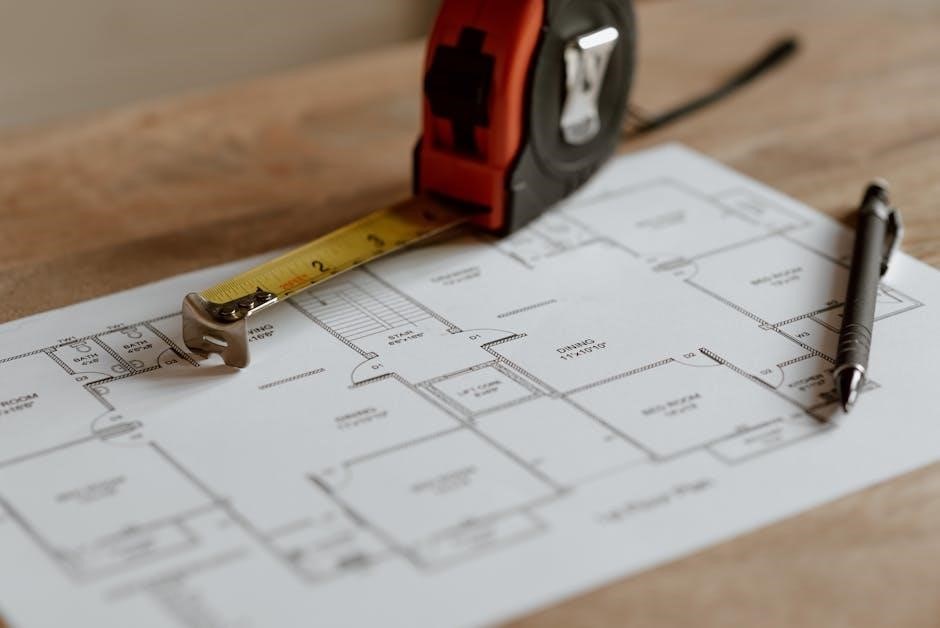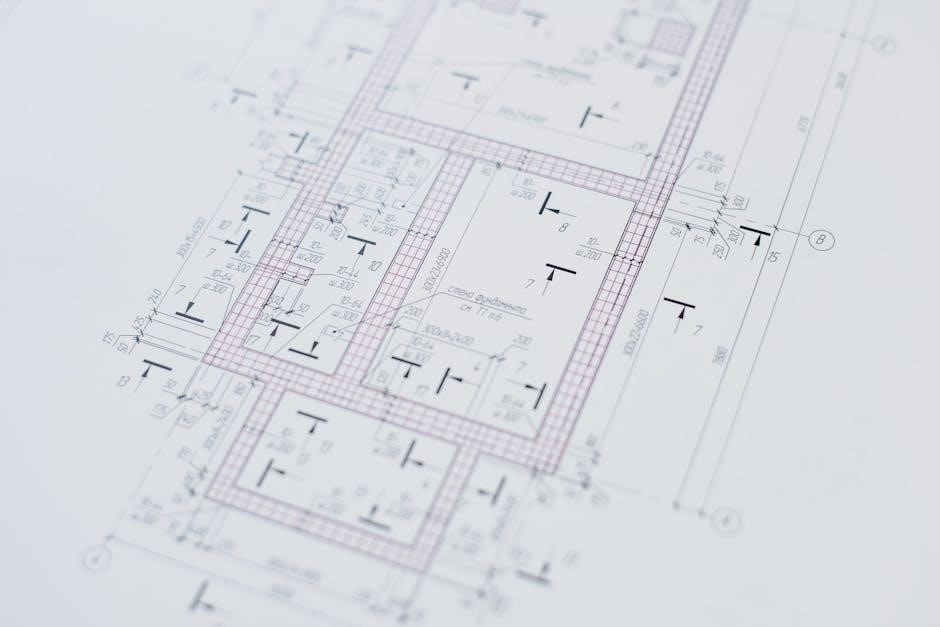ar15 schematic pdf
The AR15 schematic PDF is a detailed guide illustrating the rifle’s components and assembly, essential for understanding its design, maintenance, and customization, promoting safety and responsible ownership.

1.1 Overview of the AR15 Rifle
The AR15 is a semi-automatic, gas-operated rifle widely popular for its modularity and customization options. Designed for accuracy and reliability, it features a lightweight construction, typically using aluminum and polymer materials. Its upper and lower receiver design allows for easy assembly and disassembly, making it a favorite among enthusiasts. The AR15 platform is versatile, catering to various applications, including sporting, self-defense, and tactical use. Its ergonomic design and adjustable components ensure adaptability to different shooters’ needs, while its extensive aftermarket support enables personalized configurations.
1.2 Importance of Schematics in Firearms
Firearms schematics are essential for understanding the design, assembly, and functionality of weapons like the AR15. They provide a visual guide for identifying components, their relationships, and proper assembly procedures. Schematics are crucial for maintenance, repairs, and customization, ensuring safety and reliability. They also aid in troubleshooting by pinpointing potential issues and guiding diagnostic processes. For enthusiasts and professionals, schematics serve as a foundational reference, promoting a deeper understanding of the firearm’s mechanics. This knowledge is vital for responsible ownership, allowing users to make informed decisions and modifications while adhering to safety and legal standards.
1.3 Purpose of the Article
This article aims to provide a comprehensive guide to understanding and utilizing the AR15 schematic PDF. It is designed to help readers navigate the complexities of the AR15 platform, from its components and assembly to legal and safety considerations. Whether you’re a seasoned enthusiast or a newcomer, this guide offers practical insights to enhance your knowledge and skills. By exploring the schematic in detail, readers will gain the confidence to maintain, customize, and troubleshoot their AR15 effectively. The ultimate goal is to empower responsible ownership and promote a deeper appreciation for the firearm’s design and functionality.

History and Development of the AR15
The AR15, originally designed by ArmaLite in the 1950s, revolutionized firearms with its lightweight materials and innovative gas system, becoming a cornerstone of modern rifle design.
2.1 Origins of the AR15 Platform
The AR15 platform originated in the 1950s, developed by ArmaLite, a subsidiary of Fairchild Aircraft. Designed by Jim Sullivan and Bob Fremont, it aimed to create a lightweight, high-performance rifle using modern materials like aluminum and composite plastics. The first AR-15 prototype, chambered in 5.56mm, emphasized portability and accuracy. Its innovative design attracted the U.S. military, leading to its adoption as the M16 during the Vietnam War. The civilian version, the AR15, became popular for its versatility, spawning countless configurations and modifications, making it a cornerstone of modern firearms design and culture.
2.2 Evolution Over the Years
The AR15 platform has undergone significant evolution since its inception. Early models were refined for military use, leading to the M16. Civilian versions introduced new calibers and configurations. Advances in materials and manufacturing enabled lighter and more durable components. The development of modular accessories, such as Picatinny rails and adjustable stocks, expanded customization. Modern AR15s feature improved ergonomics, precision barrels, and versatile designs catering to hunting, competition, and self-defense. Continuous innovation has ensured the platform remains relevant, adapting to user needs and technological advancements, solidifying its place as a versatile and adaptable firearm.
2.3 Key Innovations in Design
The AR15’s design has been marked by groundbreaking innovations; The direct gas impingement system, pioneered by Eugene Stoner, reduced weight and complexity compared to traditional piston systems. The use of aluminum alloys and polymer materials allowed for a lighter and more durable firearm. The introduction of the Picatinny rail system enabled modular customization, while free-floating barrels improved accuracy. Modern designs incorporate M-LOK and KeyMod systems for accessory mounting. Ergonomic advancements, such as adjustable stocks and ambidextrous controls, enhance user adaptability. These innovations have solidified the AR15’s reputation as a versatile and cutting-edge firearm platform.

Understanding the AR15 Schematic PDF
The AR15 schematic PDF provides a detailed visual breakdown of the rifle’s components, enabling users to understand its assembly, mechanics, and customization options effectively.
3.1 Components of the Schematic
The AR15 schematic PDF typically includes detailed illustrations of the rifle’s major components, such as the upper and lower receivers, barrel, bolt carrier group, and firing mechanism. It also highlights smaller parts like the trigger assembly, magazine well, and buttstock. Additional elements may include the gas system, handguard, and accessories like scopes or rails. Each component is labeled and often accompanied by measurements and specifications, ensuring clarity for assembly, disassembly, or repair. This comprehensive breakdown allows users to understand how each part interacts within the overall design of the AR15 platform.
3.2 How to Read the Schematic
Reading an AR15 schematic PDF requires a systematic approach. Start by identifying the major components, such as the upper and lower receivers, barrel, and bolt carrier group. Pay attention to how parts are labeled and numbered, as these correspond to specific sections in the diagram. Look for arrows or lines indicating assembly or disassembly sequences. Symbols and keys are often provided to explain complex interactions. Use the diagram to cross-reference parts during assembly or repair. Begin with familiar components and gradually move to more complex systems. This method ensures clarity and precision when working with the AR15 schematic.
3.3 Symbols and Notations Used
The AR15 schematic PDF utilizes a variety of symbols and notations to convey technical information. Common symbols include dashed lines for assembly steps, color-coded components for differentiation, and specific markers for torque specifications. Notations often appear as labels or callouts, providing part numbers, dimensions, or assembly instructions. For example, a bolt carrier group might be highlighted in blue, while tolerance specifications are noted in smaller text. Understanding these symbols is crucial for accurate assembly, disassembly, and troubleshooting; Familiarity with industry-standard notations ensures users can interpret the schematic effectively, whether for DIY projects or professional applications.

Legal Considerations
Understanding federal and state laws is crucial when working with an AR15 schematic PDF. Ensure compliance with firearms regulations to maintain legal and responsible ownership and modifications.
4.1 Federal Regulations on Firearms
Federal regulations on firearms, including the AR15, are governed by laws such as the National Firearms Act (NFA) and the Gun Control Act (GCA). These laws dictate how firearms are manufactured, sold, and owned. The AR15, classified as a rifle, must comply with specific guidelines regarding barrel length, overall length, and features to avoid being classified as a regulated firearm. The Bureau of Alcohol, Tobacco, Firearms, and Explosives (ATF) enforces these regulations. Understanding and adhering to federal laws is critical to ensure legal ownership and modifications of the AR15 platform.
4.2 State-Specific Laws and Restrictions
State-specific laws and restrictions on firearms like the AR15 vary significantly across the U.S. Some states impose strict regulations, such as bans on certain features or magazine capacities, while others have more lenient policies. For example, states like California and New York require AR15s to meet specific “featureless” configurations or ban them outright. It’s crucial for owners to familiarize themselves with local laws to avoid legal consequences. These restrictions often influence how the AR15 is assembled, modified, and used within each state, emphasizing the importance of compliance with regional firearms regulations.
4.3 Responsible Use and Ownership
Responsible use and ownership of an AR15 require a deep understanding of its operation, legal compliance, and ethical considerations. Owners must ensure the firearm is stored securely to prevent unauthorized access, especially by minors. Proper training and adherence to safety protocols are essential to minimize risks. Regular maintenance, as outlined in the AR15 schematic PDF, ensures reliability and functionality. Owners should also be mindful of the intended use of the firearm, adhering to local laws and promoting a culture of safety and respect for firearms. Responsible ownership fosters trust and ensures the firearm is used appropriately and legally.

Safety Precautions
Safety is paramount when handling firearms. Always follow proper handling procedures, ensure the firearm is unloaded, and store it securely. Adhere to safety guidelines and use the schematic responsibly.
5.1 Importance of Safety When Handling Firearms

Safety is critical when handling firearms like the AR15. Mishandling can lead to accidents, injuries, or fatalities. Always treat firearms as loaded, keep fingers off the trigger until ready to shoot, and ensure the muzzle is pointed in a safe direction. Understanding proper handling techniques and adhering to safety protocols minimizes risks. Using the schematic PDF responsibly ensures that modifications or maintenance are performed correctly, reducing potential hazards. Prioritizing safety protects not only the user but also bystanders, emphasizing the importance of responsible firearm ownership and operation.
5.2 Safe Handling Practices
Safe handling practices are essential for operating the AR15. Always treat the firearm as if it is loaded, keeping your finger off the trigger until ready to shoot. Ensure the muzzle is pointed in a safe direction, away from people and valuables. Use the schematic PDF to understand proper assembly and disassembly, avoiding modifications that compromise safety. Store the firearm securely when not in use, and ensure all safety mechanisms are functioning correctly. Regular inspections and maintenance, guided by the schematic, help prevent malfunctions. Safe handling practices protect users and bystanders, fostering a culture of responsibility and awareness.
5.3 Storage and Transportation Guidelines
Proper storage and transportation of the AR15 are critical for safety and legal compliance. Store the firearm in a secure, locked container or safe, unloaded and separated from ammunition. Use a sturdy, padded case for transportation, ensuring the rifle is unloaded and secured. The schematic PDF can guide disassembly for compact storage. Always comply with federal and state laws regarding firearm storage and transport. Avoid leaving firearms in vehicles for extended periods. Keep storage locations inaccessible to children and unauthorized individuals. Regularly inspect storage containers and cases for damage or tampering to ensure security and safety.

Troubleshooting Common Issues
Using the AR15 schematic PDF, identify and diagnose common issues with detailed diagrams. Check for misalignment, wear, or improper assembly. Ensure correct installation of all components for optimal functionality and safety during troubleshooting.
6.1 Identification of Common Problems
The AR15 schematic PDF helps identify common issues such as failure to fire, feeding malfunctions, or ejection problems. By referencing the detailed diagrams, users can pinpoint potential causes like a faulty gas system, worn-out bolt carrier group, or magazine misalignment. The schematic highlights critical components, allowing for systematic troubleshooting. It also aids in diagnosing issues related to improper assembly or worn-out parts. Regular maintenance and familiarity with the schematic can prevent many of these problems, ensuring reliable performance. This visual guide is indispensable for both novice and experienced users seeking to resolve operational issues effectively.
6.2 Diagnostic Techniques Using the Schematic
The AR15 schematic PDF provides a visual roadmap for diagnosing issues, enabling users to trace problems systematically. By referencing the detailed diagrams, enthusiasts can identify failing components and understand how they interact within the system. The schematic allows for step-by-step troubleshooting, such as checking the gas system, trigger mechanism, or barrel alignment. Users can cross-reference part numbers and exploded views to pinpoint malfunctions quickly. This approach ensures that even complex issues are broken down into manageable solutions, making the schematic an indispensable tool for maintaining and repairing the AR15 platform effectively.
6.3 DIY Repair Tips and Tricks
DIY repairs on the AR15 can be streamlined using the schematic PDF, which provides clear visual guidance. Start by referencing the schematic to understand part relationships and assembly order. Always ensure the firearm is unloaded before beginning work. Use a basic toolkit, including Torx drivers, punches, and wrenches, to handle most repairs. For common issues like a faulty firing pin or loose buffer tube, follow the schematic’s exploded views to guide disassembly and reassembly. Apply threadlocker to critical screws and maintain small parts in labeled containers. If unsure, consult the schematic or practice on non-critical components first. Patience and attention to detail are key to successful DIY fixes.
The AR15 schematic PDF serves as an invaluable resource for education, maintenance, and customization, ensuring safety and responsible ownership of the firearm through clear, detailed guidance.
7.1 Summary of Key Points
This article explored the AR15 schematic PDF, emphasizing its role in firearm education, maintenance, and customization. It highlighted the importance of understanding the rifle’s components, legal compliance, and safety practices. The guide provided insights into the historical development of the AR15, troubleshooting techniques, and responsible ownership. By utilizing the schematic, users can enhance their knowledge and ensure proper assembly and functionality. The document serves as a comprehensive tool for enthusiasts, promoting safety, adherence to regulations, and effective DIY repairs. This resource is indispensable for anyone seeking to master the AR15 platform.
7.2 Final Thoughts on the AR15 Schematic PDF

The AR15 schematic PDF is an invaluable resource for firearm enthusiasts, offering detailed insights into the rifle’s mechanics and design. It serves as both an educational and practical tool, enabling users to maintain, customize, and troubleshoot their firearms effectively. By adhering to the guidance provided, individuals can ensure safety, legality, and optimal performance. This document not only empowers owners with knowledge but also fosters a deeper appreciation for the engineering behind the AR15 platform. For anyone seeking to master their rifle, the schematic PDF is an essential companion.
7.3 Encouragement for Further Learning

Continuous learning is key to mastering the AR15 platform. Explore advanced customization techniques, historical developments, and hands-on practice to deepen your expertise. Engage in firearm workshops and stay updated on new accessories and modifications. Embrace the journey of becoming an AR15 expert, enhancing your shooting accuracy and confidence. Remember, knowledge fosters safe and responsible ownership. Keep learning and enjoying the rewards of understanding and handling your rifle with precision.
